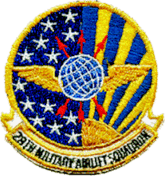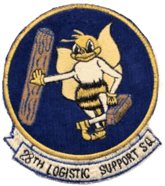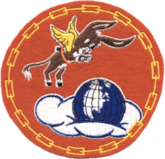28th Military Airlift Squadron
| 28th Military Airlift Squadron | |
|---|---|
.jpg) Douglas C-124 Globemaster II as flown by the 28th MAS | |
| Active | 1942–1954; 1952–1969 |
| Country | United States |
| Branch |
|
| Role | Airlift |
| Engagements | European Theater of Operations Mediterranean Theater of Operations |
| Decorations | Distinguished Unit Citation Air Force Outstanding Unit Award |
| Insignia | |
| Patch with 28th Military Airlift Squadron emblem |
 |
| Patch with 28th Logistics Support Squadron emblem |
 |
| 28th Troop Carrier Squadron (approved 25 November 1944[1] |
 |
The 28th Military Airlift Squadron is an inactive United States Air Force unit. Its last was assigned to the 62d Military Airlift Wing at Hill Air Force Base, Utah, where it was inactivated in April 1969.
The squadron was first activated as the 28th Transport Squadron in 1942. As the 28th Troop Carrier Squadron the unit saw combat in the European and Mediterranean Theaters. It earned a Distinguished Unit Citation for its combat performance.
The 28th Logistic Support Squadron was activated in 1953 at Hill Air Force Base, Utah under Air Materiel Command (AMC) as an airlift unit for special weapons under AMC control. The squadron also provided other airlift support as a secondary mission. In 1962 the squadron transferred to Military Air Transport Service.
The two squadrons were consolidated in 1985 as the 18th Airborne Command and Control Squadron but have not been active since that date.
History
World War II
Established as part of the Army Air Corps on 1 February 1942 at Daniel Field, Georgia. Equipped with C-47 Skytrain transports as one of the original four squadrons of the 89th Transport Group.[2] The 89th group provided transition training for transport pilots.[2] However, a little more than three months later, the squadron was reassigned to the 60th Transport Group at Westover Field, Massachusetts.[1]

The 60th group at Westover was preparing for shipment overseas, and the squadron trained and trained for combat resupply and casualty evacuation missions. Was ordered deployed to England, assigned to Eighth Air Force in June 1942. Assigned fuselage code 3D. Performed intro-theater transport flights of personnel, supply and equipment within England during summer and fall of 1942, reassigned to Twelfth Air Force after Operation Torch invasion of North Africa in November 1942, transporting paratroopers to Oran, Algeria during the early hours of Operation Torch.[3]
In combat, performed resupply and evacuation missions across Morocco, Algeria and Tunisia during North African Campaign. During June 1943, the unit began training with gliders in preparation for Operation Husky, the invasion of Sicily. It towed gliders to Syracuse, Sicily and dropped paratroopers at Catania during the operation. After moving to Sicily, the squadron airdropped supplies to escaped prisoners of war in Northern Italy in October.[3]
The unit provided support for partisans operating in the Balkans. Its unarmed aircraft flew at night over uncharted territory, landing at small unprepared airfields to provide guns, ammunition, clothing, medical supplies, gasoline, and mail to the partisans. It even carried jeeps and mules as cargo. On return trips it evacuated wounded partisans, evadees and escaped prisoners. These operations earned the squadron the Distinguished Unit Citation. It also dropped paratroopers at Megava, Greece in October 1944 and propaganda leaflets in the Balkans in the Mediterranean Theater of Operations until end of combat in Europe, May 1945.[3]
After hostilities ended, was transferred to Waller Field, Trinidad attached to the Air Transport Command Transported personnel and equipment from Brazil to South Florida along the South Atlantic Air Transport Route.[3] Squadron picked up personnel and equipment in Brazil or bases in Northern South America with final destination being Miami, Boca Raton Army Airfield or Morrison Fields in South Florida. Inactivated at the end of July 1945.[1]
Special Airlift
The 28th Logistic Support Squadron was activated at Hill Air Force Base,[4] Utah and equipped with Douglas C-124 Globemaster IIs in July 1953. Its mission was to provide worldwide airlift of special weapons and related equipment, with a secondary mission to airlift other Department of Defense cargo as required when space was available.[5]
In 1955 Air Material Command organized the 3079th Aviation Depot Wing to exercise command jurisdiction over all its logistic support squadrons.[6] Previously, the 7th, 19th and 28th Logistic Support Squadrons had been assigned to separate air materiel areas. The 3097th wing also commanded aviation depot groups[6] responsible for the storage and maintenance of special weapons.
In 1962 the squadron was transferred to Military Air Transport Service (MATS)'s 1501st Air Transport Wing at Travis Air Force Base, California.[7] It was redesignated the 28th Air Transport Squadron, but remained at Hill with the same mission (as indicated by the "Special" added to its designation). When MATS became Military Airlift Command in 1966, the squadron was renamed the 28th Military Airlift Squadron and its headquarters, now the 60th Military Airlift Wing, remained at Travis.[8] In 1967, the 60th wing retired its C-124s and the squadron was reassigned to the 62d Military Airlift Wing, which now had the global special weapons airlift support mission.[9] The squadron was inactivated in the spring of 1969.
Lineage
|
28th Troop Carrier Squadron
|
28th Military Airlift Squadron
|
Assignments
- 89th Transport Group 1 February 1942
- 60th Transport Group (later 60th Troop Carrier Group), 19 May 1942 – 31 July 1945[10]
- Ogden Air Materiel Area, 8 July 1953 (attached to 2849th Air Base Wing)
- 3079th Aviation Depot Wing, 8 February 1955
- 1501st Air Transport Wing, 18 January 1962[7]
- 60th Military Airlift Wing, 8 January 1966[8] (attached to 62d Military Airlift Wing 1–8 July 1967)[9]
- 62d Military Airlift Wing, 8 July 1967 – 8 April 1969[9]
Stations
|
|
Aircraft
- Douglas C-47, 1942–1945[10]
- Douglas C-124 Globemaster II, 1952–1969
Awards and Campaigns
| Award streamer | Award | Dates | Notes |
|---|---|---|---|
| Distinguished Unit Citation | 28 March 1944-15 September 1944 | 28th Troop Carrier Squadron[1] | |
| Air Force Outstanding Unit Award | 1 January 1962-31 December 1962 | 28th Logistic Support Squadron (later 28th Air Transport Squadron)[14] | |
| Air Force Outstanding Unit Award | 1 July 1965-30 June 1966 | 28th Air Transport Squadron (later 28th Military Airlift Squadron)[14][15] | |
| Air Force Outstanding Unit Award | 1 July 1966-30 June 1967 | 28th Military Airlift Squadron[15] |
| Campaign Streamer | Campaign | Dates | Notes |
|---|---|---|---|
| Tunisia | 14 November 1942 – 13 May 1943 | 28th Troop Carrier Squadron[1] | |
| Sicily | 14 May 1943 – 17 August 1943 | 28th Troop Carrier Squadron[1] | |
| Naples-Foggia | 18 August 1943 – 21 January 1944 | 28th Troop Carrier Squadron[1] | |
| Rome-Arno | 22 January 1944 – 9 September 1944 | 28th Troop Carrier Squadron[1] | |
| North Apennines | 10 September 1944 – 4 April 1945 | 28th Troop Carrier Squadron[1] | |
| Po Valley | 3 April 1945 – 8 May 1945 | 28th Troop Carrier Squadron[1] | |
| Air Combat, EAME Theater | 28 July 1942 – 11 May 1945 | 28th Troop Carrier Squadron[1] | |
References
Notes
- 1 2 3 4 5 6 7 8 9 10 11 Maurer, Combat Squadrons, pp. 144–145
- 1 2 Maurer, Combat Units, pp. 154–155
- 1 2 3 4 Maurer, Combat Units, pp. 123–125
- 1 2 Mueller, p. 243
- ↑ Abstract, History 28 Logistic Support Squadron Jan–Jun 1955 Retrieved 26 December 2013
- 1 2 Abstract, History 3079 Aviation Depot Wing Jan–Jun 1956 Retrieved 26 December 2013
- 1 2 Abstract, History 1501 Air Transport Wing Jan–Jun 1963 Retrieved 26 December 2013
- 1 2 Ravenstein, p. 95
- 1 2 3 Ravenstein, p. 99
- 1 2 3 4 Lineage of 28th Troop Carrier Squadron, including assignments, stations and aircraft in Maurer, Combat Squadrons, pp. 144–145
- 1 2 Department of the Air Force/MPM Letter 662q, 19 September 85, Subject: Reconstitution, Redesignation, and Consolidation of Selected Air Force Tactical Squadrons
- 1 2 See Mueller, p. 243
- 1 2 Station numbers in Anderson
- 1 2 AF Pamphlet 900-2, 15 June 1971, p. 151
- 1 2 AFP 900-2 15 June 1971, p. 153
Bibliography
![]()
- Anderson, Capt. Barry (1985). Army Air Forces Stations: A Guide to the Stations Where U.S. Army Air Forces Personnel Served in the United Kingdom During World War II (PDF). Maxwell AFB, AL: Research Division, USAF Historical Research Center. Retrieved 7 July 2012.
- Maurer, Maurer, ed. (1983) [1961]. Air Force Combat Units of World War II (PDF) (reprint ed.). Washington, DC: Office of Air Force History. ISBN 0-912799-02-1. LCCN 61060979.
- Maurer, Maurer, ed. (1982) [1969]. Combat Squadrons of the Air Force, World War II (PDF) (reprint ed.). Washington, DC: Office of Air Force History. ISBN 0-405-12194-6. LCCN 70605402. OCLC 72556.
- Mueller, Robert (1989). Air Force Bases, Vol. I, Active Air Force Bases Within the United States of America on 17 September 1982 (PDF). Washington, DC: Office of Air Force History. ISBN 0-912799-53-6.
- Ravenstein, Charles A. (1984). Air Force Combat Wings, Lineage & Honors Histories 1947–1977 (PDF). Washington, DC: Office of Air Force History. ISBN 0-912799-12-9.
- AF Pamphlet 900-2, Unit Decorations, Awards and Campaign Participation Credits Department of the Air Force, Washington, DC, 15 June 1971
Further reading
- Ulanoff, Stanley M. (1964). MATS: The Story of the Military Air Transport Service. New York, NY: Franklin Watts, Inc. ISBN 978-1-19908-768-3.